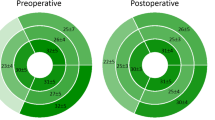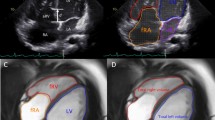Abstract
Although the Cone procedure has improved outcomes for patients with Ebstein´s anomaly (EA), neither RV systolic function recovery in long-term follow-up nor the best echocardiographic parameters to assess RV function are well established. Thus, we evaluated RV performance after the Cone procedure comparing two-dimensional (2DEcho) and three-dimensional (3DEcho) echocardiography to cardiac magnetic resonance (CMR). We assessed 27 EA patients after the Cone procedure (53% female, median age of 20 years at the procedure, median post-operative follow-up duration of 8 years). Echocardiography was performed 4 h apart from the CMR. RV global longitudinal strain (GLS), fractional area change (FAC), tricuspid annular plane systolic excursion (TAPSE), myocardial performance index and tissue Doppler S’ velocity were assessed using 2DEcho, whereas 3DEcho was used to evaluate RV volumes and ejection fraction (RVEF). Echocardiographic variables were compared to CMR-RVEF. All patients were in the NYHA functional class I. Median TAPSE was 15.9 mm, FAC 30.2%, and RV-GLS -15%; median RVEF by 3DEcho was 31.9% and 43% by CMR. Among 2DEcho parameters, RV-GLS and FAC had a substantial correlation with CMR-RVEF (r = − 0.63 and r = 0.55, respectively); from 3DEcho, the indexed RV volumes and RVEF were closely correlated with CMR (RV-EDVi, r = 0.60, RV-ESVi, r = 0.72; and RVEF r = 0.60). RV systolic function is impaired years after the Cone procedure, despite a good clinical status. FAC and RV-GLS are useful 2DEcho tools to assess RV function in these patients; however, 3DEcho measurements appear to provide a better RV assessment.








Similar content being viewed by others
Abbreviations
- EA:
-
Ebstein’s anomaly
- RV:
-
Right ventricle
- 2DEcho:
-
Two-dimensional echocardiography
- 3DEcho:
-
Three-dimensional echocardiography
- RVEF:
-
Right ventricle ejection fraction
- CMR:
-
Cardiac magnetic resonance
- TR:
-
Tricuspid regurgitation
- RV-GLS:
-
Right ventricular global longitudinal strain
- RV-FLS:
-
Right ventricular free wall longitudinal strain
- FAC:
-
Fractional area change
- TAPSE:
-
Tricuspid annular plane systolic excursion
- MPI:
-
Myocardial performance index
- RV-EDV:
-
Right ventricle end-diastolic volume
- RV-EDVi:
-
Indexed right ventricle end-diastolic volume
- RV-ESV:
-
Right ventricle end-systolic volume
- RV-ESVi:
-
Indexed right ventricle end-systolic volume
- NYHA:
-
New York Heart Association
References
Brown ML, Dearani JA (2009) Ebstein malformation of the tricuspid valve: current concepts in management and outcomes. Curr Treat Options Cardiovasc Med 11:396–402
Brown ML, Dearani JA (2011) Ebstein anomaly. In: Gatzoulis MA, Webb GD, Daubeney PEF (eds) Diagnosis and Management of adult congenital heart disease, vol 39. Elsevier Saunders, Philadelphia, pp 288–294
Anderson KR, Lie JT (1979) The right ventricular myocardium in Ebstein’s anomaly: a morphometric histopathologic study. Mayo Clin Proc 54:181–184
Lee CM, Sheehan FH, Bouzas B, Chen SS, Gatzoulis MA, Kilner PJ (2013) The shape and function of the right ventricle in Ebstein’s anomaly. Int J Cardiol 167:704–710
Gutberlet M, Oellinger H, Ewert P, Nagdyman N, Amthauer H, Hoffmann T et al (2000) Pre- and post-operative evaluation of ventricular function, muscle mass and valve morphology by magnetic resonance tomography in Ebstein’s anomaly. Rofo 172:436–442
Therrien J, Henein MY, Li W, Somerville J, Rigby M (2000) Right ventricular long axis function in adults and children with Ebstein’s malformation. Int J Cardiol 73:243–249
Vettukattil JJ, Bharucha T, Anderson RH (2007) Defining Ebstein’s malformation using three-dimensional echocardiography. Interact Cardiovasc Thorac Surg 6:685–690
Lu X, Vyacheslav N, Bu L, Stolpen A, Ayres N, Pignatelli RH et al (2008) Accuracy and reproducibility of real-time three-dimensional echocardiography for assessment of right ventricular volumes and ejection fraction in children. J Am Soc Echocardiogr 21:84–89
da Silva JP, Baumgratz JF, da Fonseca L, Franchi SM, Lopes LM, Tavares GM et al (2007) The cone reconstruction of the tricuspid valve in Ebstein’s anomaly. The operation: early and midterm results. J Thorac Cardiovasc Surg 133:215–223
Anderson HN, Dearani JA, Said SM, Norris MD, Pundi KN, Miller AR et al (2014) Cone reconstruction in children with Ebstein anomaly: the Mayo Clinic experience. Congenit Heart Dis 9:266–271
Dearani JA, Said SM, O’Leary PW, Burkhart HM, Barnes RD, Cetta F (2013) Anatomic repair of Ebstein’s malformation: lessons learned with cone reconstruction. Ann Thorac Surg, 95:220–6; discussion 6–8
Vogel M, Marx GR, Tworetzky W, Cecchin F, Graham D, Mayer JE et al (2012) Ebstein’s malformation of the tricuspid valve: short-term outcomes of the ‘‘cone procedure’’ versus conventional surgery. Congenit Heart Dis 7:50–58
Lange R, Burri M, Eschenbach LK, Badiu CC, daSilva JP, Nagdyman N, et al (2015) Da Silva’s cone repair for Ebstein’s anomaly: effect on right ventricular size and function. Eur J Cardio Thorac Surg 48(2):316–320
Ibrahim M, Tsang VT, Caruana M, Hughes ML, Jenkyns S, Perdreau E et al (2015) Cone reconstruction for Ebstein’s anomaly: patient outcomes, biventricular function and cardiopulmonary exercise capacity. J Thorac Cadiovasc Surg 149(9):1144–1150
Lang RM, Badano LP, Mor-Avi V, Afilalo J, Armstrong A, Ernande L et al (2015) Recommendation for cardiac chamber quantification by Echocardiography in adults: an update from the American Society of Echocardiorgaphy and the European Association of Cardiovascular Imaging. J Am Soc Echocardiogr 28(1):1–39e14
Morris DA, Krisper M, Nakatani S, Kohncke C, Otsuji Y, Belyavskiy E et al (2017) Normal range and usefulness of right ventricular systolic strain to detect subtle right ventricular systolic abnormalities in patiens with heart failure: a multicentre study. Eur Heart J Cardiovasc Imaging 18(2):212–223
Zoghbi WA, Adams D, Bonow RO, Enriquez-Sarano M, Foster E, Graysburn PA et al (2017) Recommendations for noninvasive evaluation of native valvular regurgitation. A report from the American Society of Echocardiography developed in collaboration with the Society for Cardiovascular Magnetic Resonance. J Am Soc Echocardiogr 30(4):303–371
Perdreau E, Tsang V, Hughes ML, Ibrahim M, Kataria S, Janagarajan K et al (2018) Change in biventricular function after cone reconstruction of Ebstein´s anomaly: an echocardiographic study. Eur Heart J Cardiovasc Imaging 19(7):808–815
Prakasa KR, Wang J, Tandri H, Dalai D, Bomma C, Chojnowski R et al (2007) Utility of tissue Doppler and strain echocardiography in arrythmogenic right ventricular dysplasia/cardiomyopathy. Am J Cardiol 100(3):507–512
Kühn A, Meierhofer C, Rutz T, Rondak I-C, Röhlig C, Schreiber C et al (2016) Non-volumetric echocardiographic indices and qualitative assessment of right ventricular systolic function in Ebstein’s anomaly: comparison with CMR-derived ejection fraction in 49 patients. Eur Heart J Cardiovasc Imaging 17:930–935
Avitabile CM, Whitehead K, Fogel M, Mercer-Rosa L (2014) Tricuspid annular plane systolic excursion does not correlate with right ventricular ejection fraction in patients with hypoplastic left heart syndrome after Fontan operation. Pediatr Cardiol 35(7):1253–1258
Pettersen E, Helle-Valle T, Edvardsen T, Lindberg H, Smith HJ, Smevik B et al (2007) Contraction pattern of the systemic right ventricle shift from longitudinal to circumferential shortening and absent global ventricular torsion. J Am Coll Cardiol 49:2450–2456
Sheehan FH, Ge S, Vick GW III, Urnes K, Kerwin WS, Bolson EL et al (2008) Three-dimensional shape analysis of right ventricular remodeling in repaired tetralogy of Fallot. Am J Cardiol 101:107–113
Van der Zwann HB, Geleijnse NL, McGhie JS, Boersma E, Helbing WA, Meijboom FJ et al (2011) Right ventricular quantification in clinical practice: two-dimensional vs* three-dimensional echocardiography compared with cardiac magnetic resonance imaging. Eur J Echocardiogr 12(9):656–664
Kühl HP, Schreckenberg M, Rulands D, Katoh M, Schäfer W, Schummers G et al (2004) High-resolution transthoracic real-time three-dimensional echocardiography: quantification of cardiac volumes and function using semi-automatic border detection and comparison with cardiac magnetic resonance imaging. J Am Coll Cardiol 43(11):2083–2090
Ostenfeld E, Carlsson M, Shahgaldi K, Roijer A, Holm J (2012) Manual correction of semi-automatic three-dimensional echocardiography is needed for right ventricular assessment in adults; validation with cardiac magnetic resonance. Cardiovasc Ultrasound. https://doi.org/10.1186/1476-7120-10-1
Crean AM, Maredia N, Ballard G, Menezes R, Whartson G, Foster J et al (2011) 3D Echo systematically underestimated right ventricular volumes compared to cardiovascular magnetic resonance in adult congenital heart disease with moderate to severe RV dilatation. J Cardiovasc Magn Reson 13(1):78
Funding
This research did not receive any specific grant from funding agencies in the public, commercial, or not-for-profit sectors. Dr. Mercer-Rosa is supported by grant NIH K01HL125521 and by Pulmonary Hypertension Association Supplement to K01HL125521.
Author information
Authors and Affiliations
Corresponding author
Ethics declarations
Conflict of interest
The authors declare that they have no conflicts of interest.
Additional information
Publisher's Note
Springer Nature remains neutral with regard to jurisdictional claims in published maps and institutional affiliations.
Rights and permissions
About this article
Cite this article
Lianza, A.C., Rodrigues, A.C.T., Mercer-Rosa, L. et al. Right Ventricular Systolic Function After the Cone Procedure for Ebstein's Anomaly: Comparison Between Echocardiography and Cardiac Magnetic Resonance. Pediatr Cardiol 41, 985–995 (2020). https://doi.org/10.1007/s00246-020-02347-6
Received:
Accepted:
Published:
Issue Date:
DOI: https://doi.org/10.1007/s00246-020-02347-6




